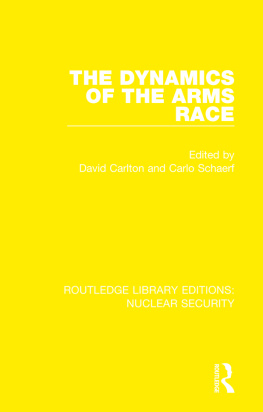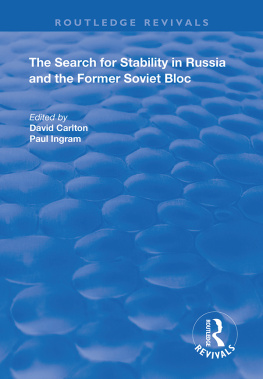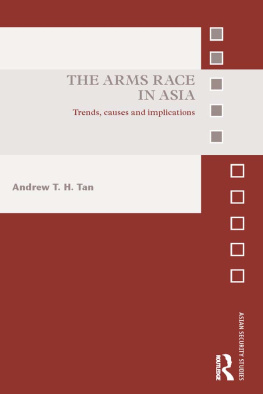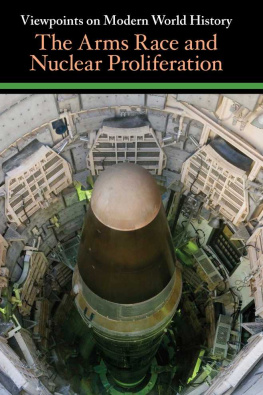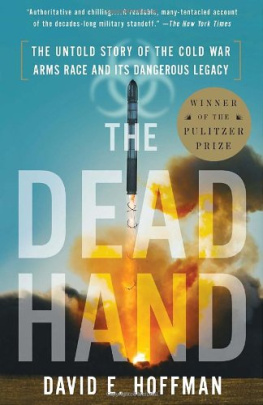ROUTLEDGE LIBRARY EDITIONS: NUCLEAR SECURITY
Volume 21
THE DYNAMICS OF THE ARMS RACE
First published in 1975 by Croom Helm
This edition first published in 2021
by Routledge
2 Park Square, Milton Park, Abingdon, Oxon OX14 4RN
and by Routledge
52 Vanderbilt Avenue, New York, NY 10017
Routledge is an imprint of the Taylor & Francis Group, an informa business
1975 International School on Disarmament and Research on Conflicts Fourth Course
All rights reserved. No part of this book may be reprinted or reproduced or utilised in any form or by any electronic, mechanical, or other means, now known or hereafter invented, including photocopying and recording, or in any information storage or retrieval system, without permission in writing from the publishers.
Trademark notice: Product or corporate names may be trademarks or registered trademarks, and are used only for identification and explanation without intent to infringe.
British Library Cataloguing in Publication Data
A catalogue record for this book is available from the British Library
ISBN: 978-0-367-50682-7 (Set)
ISBN: 978-1-00-309763-1 (Set) (ebk)
ISBN: 978-0-367-53298-7 (Volume 21) (hbk)
ISBN: 978-1-00-308133-3 (Volume 21) (ebk)
Publishers Note
The publisher has gone to great lengths to ensure the quality of this reprint but points out that some imperfections in the original copies may be apparent.
Disclaimer
The publisher has made every effort to trace copyright holders and would welcome correspondence from those they have been unable to trace.
The Dynamics of the Arms Race
EDITED BY DAVID CARLTON AND CARLO SCHAERF
First published 1975
1975 International School on Disarmament and Research on Conflicts Fourth Course
Croom Helm Ltd
2-10 St Johns Road London SW11
ISBN: 0-85664-270-3
Set by Red Lion Setters, Holborn, London
Printed by Biddles of Guildford
CONTENTS
J. Henk Leurdifk
Herbert F. York
Kosta Tsipis
Jack Ruina
Hans J. Morgenthau
Thomas Schelling
Kosta Tsipis
George Rathjens
Joseph Kashi
William Epstein
Jules Moch
Roberto Caracciolo
David Carlton
Francesco Cavalleti
Milan Sahovic
Jozef Goldblat
Jozef Goldblat
O.A. Reutov
Alan Dowty
Peter Kodzic
William Gutteridge
Alan Dowty
William Gutteridge
Guide
The organization of the course and the symposium was made possible by the generous collaboration and financial contributions of different organizations and individuals.
For their financial contributions we wish to express our gratitude to:
- UNESCO, in particular Prof. M. Paronetto-Valier;
- National Science Foundation (USA);
- The Ford Foundation, in particular Mr William B. Bader and Dr Alessandro Silj;
- The Italian Ministry of Foreign Affairs;
- The Italian Ministry of Public Education;
- The Italian National Research Council.
For hospitality in the City of Padua and in the Collegio Carlo Ederle we are indebted to:
- The University of Padua, sponsor of the meeting;
- The Opera Universitaria of the University of Padua and in particular its Government Commissioner, Prof. Paolo Alghisi to whom we owe the granting of the facilities of Collegio Carlo Ederle;
- The Physics Department of the University of Padua and in particular Prof. Antonio Rostagni and Prof. Claudio Villi;
- The Laboratori Nazionali di Legnaro and in particular Prof. Renato Ricci and Dr Paolo Kusstatscher.
Our stay in Padua was made particularly enjoyable by a group of our Paduan friends who volunteered a very large amount of their time to ensure efficient organization. Special thanks are due to Dr Alessandro Pascolini, member of our Board of Directors and Secretary of the School, with his wife Maria Rosa, and Dr Luigi Filippo Dona dalle Rose.
Dr Smeralda Bozzo and Mr Fernando Pacciani collaborated in the preparatory work in Frascati.
We would also like to acknowledge the dedicated collaboration of Mrs and Mr Giorgio Gregori, Miss Viviana Panaccia, Mr Mauro Pascolini and the staff of Collegio Carlo Ederle.
The editors are grateful for technical advice on contributions from Dr Julian Perry Robinson of the University of Sussex and to Dr John Beckman of Queen Mary College, London.
David Carlton
Carlo Schaerf
J. Henk Leurdijk
Introduction
It should be recognised that this summary of the lectures and discussions is biased as to the selection of the items and may be unbalanced in its presentation. This is so for two reasons: first, no written records were made of the discussions so that the summary is a highly personal view of the course and the symposium, and second, the discussions often covered a wide range of subjects occasionally in a rather undisciplined fashion, whereas this summary tries to structure the discussions in a possibly artificially systematic way.
This summary is organised along the same lines as the presentation of the articles: first, the nuclear arms race in terms of its technological aspects and its political implications; second, biological and chemical weapons; and finally, theory of conflict and some regional case studies.
Nuclear Weapons
The main focus of the school and the symposium was on the nuclear arms race. Any full-scale discussion of this subject has to touch upon a number of interdependent aspects: the technological aspects of strategic and tactical nuclear weapon systems, and their political implications, that is the systematic exposition of ideas of how to use them (strategic and tactical nuclear doctrines) and how to control and eliminate them (nuclear arms control and disarmament). Often these aspects are treated separately, although fully to comprehend the phenomenon of the arms race and its relevance or irrelevance involves studying how they interact. Weapons and strategy interact because it is the quality of nuclear weapons that determines their strategic uses, while at the same time strategic thinking may be an important factor in weapon developments. In addition, it is necessary to consider how the efforts to control the arms race can be understood in terms of some organising principle which relates them with the on-going arms race, thereby making a certain pattern visible instead of treating arms control agreement as unique phenomena.
There is ample evidence that at present the nuclear arms race is strongly technologically determined. In his lecture on the origins of Multiple Independently Targetable Re-entry Vehicles (MIRVs), Herbert York explained that in this case almost all decisions were influenced by considerations of technology while the political implications did not enter into the process until it was too late to have any effect. Strategic nuclear weapon systems and their development were described in great detail by three American scientists. Kosta Tsipis dealt with the sea-based deterrent consisting of nuclear missile-carrying submarines (SLBMs) which he described as the ideal deterrent weapons for the future. Their mobility in a water environment makes then invulnerable to a pre-emptive first strike from an opponent and for the same reasons they are unsuitable for delivering a first strike against the enemy weapons. On the other hand, the land-based part of the deterrent (ICBMs) is becoming less important because the fixed position of land-based missiles makes them at the same time vulnerable to a pre-emptive first strike and suitable as a first strike weapon against the opponent as a result of the high accuracy of their delivery. Adopting a launch-on-warning posture would introduce destabilizing elements into the deterrent situation which arms control agreements are trying to prevent. The history of three weapon systems (ICBM, MIRV and ABM) was outlined by Herbert York, who described in great detail the interaction of strategic, political and technological motivations in their development. The most recent destabilizing factor in the offensive missiles race was the introduction and development by the United States of the MIRV. The development of this weapon was described by Herbert York as a result of the coincidence of different motivations held by different groups of people: some gave priority to the maintenance of the American deterrent as a means of dealing with the Soviet ABM system; the Air Force stressed the increase in the number of points that could be targeted with MIRVs in a counter-force posture; while the arms controllers in the American Government saw MIRVs as a device to prevent the building of more missiles.


